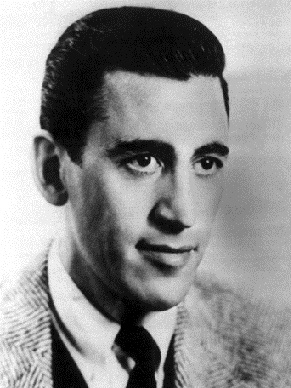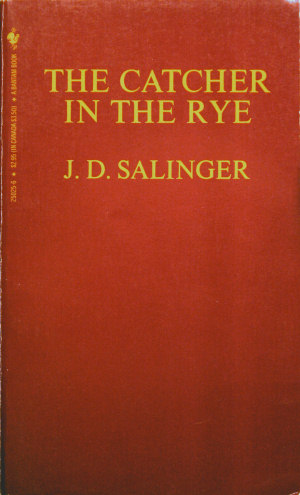Profile: J.D. Salinger/The Catcher in the Rye

I've read this book probably a dozen times. I began reading it in high school and have read it every couple of years since. The book is brilliant and everyone should read this book at some point in their lives.
J.D. Salinger

Jerome David Salinger (pronounced /ˈsælɪndʒər/, SAL-in-jər; January 1, 1919 – January 27, 2010) was an American author, best known for his 1951 novel The Catcher in the Rye, as well as his reclusive nature. His last original published work was in 1965; he gave his last interview in 1980. Raised in Manhattan, Salinger began writing short stories while in secondary school, and published several stories in the early 1940s before serving in World War II. In 1948 he published the critically acclaimed story "A Perfect Day for Bananafish" in The New Yorker magazine, which became home to much of his subsequent work. In 1951 Salinger released his novel The Catcher in the Rye, an immediate popular success. His depiction of adolescent alienation and loss of innocence in the protagonist Holden Caulfield was influential, especially among adolescent readers. The novel remains widely read and controversial, selling around 250,000 copies a year.
The success of The Catcher in the Rye led to public attention and scrutiny: Salinger became reclusive, publishing new work less frequently. He followed Catcher with a short story collection, Nine Stories (1953), a collection of a novella and a short story, Franny and Zooey (1961), and a collection of two novellas, Raise High the Roof Beam, Carpenters and Seymour: An Introduction (1963). His last published work, a novella entitled "Hapworth 16, 1924", appeared in The New Yorker on June 19, 1965.
Afterward, Salinger struggled with unwanted attention, including a legal battle in the 1980s with biographer Ian Hamilton and the release in the late 1990s of memoirs written by two people close to him: Joyce Maynard, an ex-lover; and Margaret Salinger, his daughter. In 1996, a small publisher announced a deal with Salinger to publish "Hapworth 16, 1924" in book form, but amid the ensuing publicity, the release was indefinitely delayed. He made headlines around the globe in June 2009, after filing a lawsuit against another writer for copyright infringement resulting from that writer's use of one of Salinger's characters from The Catcher in the Rye. Salinger died of natural causes on January 27, 2010, at his home in Cornish, New Hampshire.
The Catcher in the Rye

In the 1940s, Salinger confided to several people that he was working on a novel featuring Holden Caulfield, the teenage protagonist of his short story "Slight Rebellion off Madison", and The Catcher in the Rye was published on July 16, 1951. The novel's plot is simple, detailing seventeen-year-old Holden's experiences in New York City following his expulsion, and departure, from an elite prep school. The book is more notable for the iconic persona and testimonial voice of its first-person narrator, Holden. He serves as an insightful but unreliable narrator who expounds on the importance of loyalty, the "phoniness" of adulthood, and his own duplicity. In a 1953 interview with a high-school newspaper, Salinger admitted that the novel was "sort of" autobiographical, explaining that "My boyhood was very much the same as that of the boy in the book ... [I]t was a great relief telling people about it."
Initial reactions to the book were mixed, ranging from The New York Times's hailing of Catcher as "an unusually brilliant first novel" to denigrations of the book's monotonous language and the "immorality and perversion" of Holden, who uses religious slurs and freely discusses casual sex and prostitution. The novel was a popular success; within two months of its publication, The Catcher in the Rye had been reprinted eight times. It spent thirty weeks on the New York Times Bestseller list.
The book's initial success was followed by a brief lull in popularity, but by the late 1950s, according to Ian Hamilton, it had "become the book all brooding adolescents had to buy, the indispensable manual from which cool styles of disaffectation could be borrowed." Newspapers began publishing articles about the "Catcher Cult," and the novel was banned in several countries—as well as some U.S. schools—because of its subject matter and what Catholic World reviewer Riley Hughes called an "excessive use of amateur swearing and coarse language." One diligent parent counted 237 appearances of the word "goddam" in the novel, along with 58 of "bastard", 31 of "Chrissake" and 6 of "[frick]".
In the 1970s, several U.S. high school teachers who assigned the book were fired or forced to resign. In 1979 one book-length study of censorship noted that The Catcher in the Rye "had the dubious distinction of being at once the most frequently censored book across the nation and the second-most frequently taught novel in public high schools", (after John Steinbeck's Of Mice and Men) The book remains widely read; as of 2004, the novel was selling about 250,000 copies per year, "with total worldwide sales over 65 million".
In the wake of its 1950s success, Salinger received (and rejected) numerous offers to adapt The Catcher in the Rye for the screen, including one from Samuel Goldwyn.[38] Since its publication, there has been sustained interest in the novel among filmmakers, with Billy Wilder, Harvey Weinstein, and Steven Spielberg among those seeking to secure the rights. Salinger stated in the 1970s that "Jerry Lewis tried for years to get his hands on the part of Holden." Salinger repeatedly refused, though, and in 1999, Joyce Maynard definitively concluded: "The only person who might ever have played Holden Caulfield would have been J. D. Salinger."
List of Works
Books
The Catcher in the Rye (1951)
Nine Stories (1953)
"A Perfect Day for Bananafish" (1948)
"Uncle Wiggily in Connecticut" (1948)
"Just Before the War with the Eskimos" (1948)
"The Laughing Man" (1949)
"Down at the Dinghy" (1949)
"For Esmé – with Love and Squalor" (1950)
"Pretty Mouth and Green My Eyes" (1951)
"De Daumier-Smith's Blue Period" (1952)
"Teddy" (1953)
Franny and Zooey (1961)
"Franny" (1955)
"Zooey" (1957)
Raise High the Roof Beam, Carpenters and Seymour: An Introduction (1963)
"Raise High the Roof-Beam, Carpenters" (1955)
"Seymour: An Introduction" (1959)
Published and anthologized stories
"Go See Eddie" (1940, republished in Fiction: Form & Experience, ed. William M. Jones, 1969)
"The Hang of It" (1941, republished in The Kit Book for Soldiers, Sailors and Marines, 1943)
"The Long Debut of Lois Taggett" (1942, republished in Stories: The Fiction of the Forties, ed. Whit Burnett, 1949)
"A Boy in France" (1945, republished in Post Stories 1942–45, ed. Ben Hibbs, 1946)
"This Sandwich Has No Mayonnaise" (1945, republished in The Armchair Esquire, ed. L. Rust Hills, 1959)
"A Girl I Knew" (1948, republished in Best American Short Stories 1949, ed. Martha Foley, 1949)
"Slight Rebellion off Madison" (1946, republished in Wonderful Town: New York Stories from The New Yorker, ed. David Remnick, 2000)
Published and unanthologized stories
"The Young Folks" (1940)
"The Heart of a Broken Story" (1941)
"Personal Notes of an Infantryman" (1942)
"The Varioni Brothers" (1943)
"Both Parties Concerned" (1944)
"Soft-Boiled Sergeant" (1944)
"Last Day of the Last Furlough" (1944)
"Once a Week Won't Kill You" (1944)
"Elaine" (1945)
"The Stranger" (1945)
"I'm Crazy" (1945)
"A Young Girl in 1941 with No Waist at All" (1947)
"The Inverted Forest" (1947)
"Blue Melody" (1948)
"Hapworth 16, 1924" (1965)
Unpublished and unanthologized stories
"The Ocean Full of Bowling Balls" (date unknown)
"The Last and Best of the Peter Pans" (date unknown)
"Two Lonely Men" (1944)
"The Children's Echelon" (1944)
"The Magic Foxhole" (1945)
Source Site:
http://en.wikipedia.org/wiki/J._D._Salinger
|
0
|

|
|
0
|

|
|
|
DCF
3/15/2010
DISCLAIMER: This posting was submitted by a user of the site not from Earth's Mightiest editorial staff. All users have acknowledged and agreed that the submission of their content is in compliance with our Terms of Use. For removal of copyrighted material, please contact us HERE.